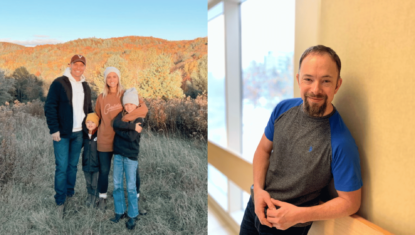11/06/2025
Ottawa, Ontario — Wednesday June 11, 2025

Tamy Bell is learning how to live with grief.
Her son, Griffin, died in March 2024 at the age of six from Neuroblastoma, a cancer of the nervous system and the second most common childhood cancer to leukemia.
Bell has tried to take her painful experience and use it to help others. One way being getting involved in childhood cancer research.
“I get to tell our story and talk about him. I get to keep his legacy alive,” said Bell.
Bell is part of the CHEO Research Institute’s Research Family Leader Program. She serves as a family advisor on a research study by Dr. Shawn Beug who is trying to use cells from nervous system tumours, and some brain cancer tumours, to harness the body’s own immune system and remove cancer cells.
This is one of 30 oncology-related multi-centre studies run by the CHEO Research Institute, and CHEO wants to make it easier for families, caregivers and parents like Bell to participate in research.
As of Feb. 1, 2025, children and youth who receive services at CHEO are automatically included in the Research Connection program, which links more children, youth, and families to valuable research opportunities.
The program also improves the quality of research findings through better equity and access to research.
CHEO is the first acute care pediatric hospital to implement a program like this. The launch of Research Connection follows extensive engagement with family partners, researchers, hospital leaders, and the CHEO Research Ethics Board. The program also underwent a detailed legal and privacy review and approval from both the CHEO and CHEO Research Institute boards of directors.
This engagement also informed the robust education and awareness campaign to advise CHEO families about Research Connection, including a graphic explainer video available in multiple languages and a detailed webpage.
This helps CHEO families understand that being part of Research Connection doesn’t mean their child or youth is automatically enrolled in a research study, rather they may be approached to ask if they want to learn more about a study they may be eligible for.
“We should all be a part of research and, for me, being involved in research is just another part of that journey to honour Griff,” said Bell.
Before Research Connection was introduced, research teams needed someone from a patient’s direct circle of care – like doctors, nurses, or therapists – to ask the patient or family if a researcher could contact them to tell them about a research study.
Now, approved researchers can contact those on the secure contact list directly by phone, MyChart, or in person during a visit to ask if a patient or family wants to learn about a research study opportunity.
Families can then choose whether they want to learn about the study and whether they want to participate, on a study-by-study basis, without any impact on their care received at CHEO.
It’s also easy for patients and families to withdraw from Research Connection if they don’t want to be contacted about research opportunities at CHEO.
You can learn more about the Research Connection program on its website.
Research also relies on the generosity of community donors to the CHEO Foundation, which is why Bell works hard to raise money, especially at the annual CN Cycle of CHEO,
She said pediatric cancer research needs a boost in funding.
“Kids shouldn’t have to die of cancer,” she said.
You can learn more about Griffin Bell’s story on the CHEO Foundation website.
